Uncategorized
2 Jewish community leaders missing in Antakya, Turkish city devastated by earthquakes
ISTANBUL (JTA) – After initially sounding the all clear in the hours after a devastating earthquake Monday, the Turkish Jewish community now says that two prominent members remain missing in Antakya, a city near the Syrian border with a long Jewish history.
The leader of the Jewish community of Antakya, Saul Cenudioğlu, and his wife Fortuna have been missing since their apartment building collapsed in the first of two quakes on Monday morning, according to Cenudioğlu’s niece Ela.
Ela Cenudioğlu described her uncle as “a visionary leader committed to the Jewish community and the values it represents.” She said he had, since his birth in 1941, lived in Antakya, where the family operated a textile business.
Saul “did everything in his capacity to have the small Jewish community of Antakya thrive and connect with the rest of the communities in Turkey and the world,” she told the Jewish Telegraphic Agency. “I deeply hope that he and his wife (who has always been a mother to me) come out of this safely, for all I wish is to see his kind smile and hug him again.”
A grim toll is continuing to mount in Turkey, where the official death toll has already exceeded 5,000 and the WHO warns it could surpass 20,000. More than 1,200 buildings were destroyed in Antakya’s province alone and over 6,000 are estimated to have been destroyed across southern Turkey, and rescue teams are racing against time to identify people who might be buried alive under the rubble.
Saul’s brother, Azur Cenudioğlu, was in Antakya during the quake but managed to get out safely, according to Ynet. About his brother and sister-in-law, he said, “I am going back there to look for them and fear I may not find them alive.”
Antakya’s 100-year-old synagogue was also heavily damaged. Video circulated on social media showing community members retrieving Torah scrolls that appeared to be damaged.
Saving ancient Torah scrolls from the earthquake damaged synagogue of Antakya – home for a Jewish community for 2500 years… #antakyadeprem pic.twitter.com/ZsHzVKdHWZ
— Rabbi Mendy Chitrik (@mchitrik) February 7, 2023
Jews have been present in the city, known in antiquity as Antioch, for millennia, since its founding under the Selucid empire. The city was governed by Antiochus, the villain of the Hanukkah story; is frequently mentioned in the Talmud; and was a major center of Jewish scholarship in ancient times. Once closely associated with the larger Jewish community of neighboring Aleppo, the city’s Jewish population had dwindled to just 14 in recent years.
Now, Turkish Jews say, it’s unlikely that any will remain.
“The end of a 2500 year old love story,” the Turkish Jewish Community’s president, Ishak Ibrahimzade wrote on Twitter.
“Along with our historical Antakya Synagogue, 2500 years of Jewish life came to an end with this great pain…,” the Turkish Jewish community tweeted with a picture of the synagogue’s Torah scrolls being removed from a severely damaged room.
Israeli aid workers from a variety of organizations have landed in Turkey and plan to assist in search, rescue and recovery in the devastated southeastern portion of the country. Many expect to be in the region for weeks to come.
“We’re headed to Gaziantep with emergency relief supplies including water filters, water filtration systems, hygiene kits, mental health and resilience kits,” IsraAid’s spokesperson told JTA. “In the first two weeks we’ll assess the needs on the ground, and explore a wider range, longer term response.”
An immediate concern is providing safe shelter for those who were displaced by the quakes.
“We woke up at 4 a.m. and the house was shaking,” Azur told Ynet. “We left in our pajamas and slippers and were unable to take anything with us. Our prayer shawls and tefillin are all buried under the rubble and we are left with nothing.”
—
The post 2 Jewish community leaders missing in Antakya, Turkish city devastated by earthquakes appeared first on Jewish Telegraphic Agency.
Uncategorized
Pakistan, Saudi in Talks on JF-17 Jets-for-Loans Deal, Sources Say

Saudi Crown Prince Mohammed bin Salman and Pakistan Prime Minister Shehbaz Sharif meet in Riyadh, Saudi Arabia, Sept. 17, 2025. Photo: Saudi Press Agency/Handout via REUTERS
Pakistan and Saudi Arabia are in talks to convert about $2 billion of Saudi loans into a JF–17 fighter jet deal, two Pakistani sources said, deepening military cooperation months after the two nations signed a mutual defense pact last year.
The talks underscore how the two allies are moving to operationalize defense cooperation at a time when Pakistan is facing acute financial strain and Saudi Arabia is reshaping its security partnerships to hedge against uncertainty about US commitments in the Middle East.
The mutual defense deal was signed following Israel’s strikes on what it said were Hamas targets in Doha, an attack that shook the Gulf region.
One of the sources said the discussions were limited to the provision of JF–17 Thunder fighter jets, the light combat aircraft jointly developed by Pakistan and China and produced in Pakistan, while the second said the jets were the primary option among others under discussion.
The first source said the total deal was worth $4 billion, with an additional $2 billion to be spent on equipment over and above the loan conversion. The sources close to the military with knowledge of the matter spoke on condition of anonymity because they were not authorized to speak on the deal.
Pakistan‘s Air Chief Zaheer Ahmed Baber Sidhu was in Saudi Arabia for bilateral talks including on “military cooperation between the two sides,” Saudi media outlet SaudiNews50 said on social media platform X on Monday.
TESTED IN COMBAT
Amir Masood, a retired Air Marshall and analyst, said Pakistan was in talks about or had finalized deals with six countries to provide equipment including JF–17s and electronic systems and weapons systems for the jets. He said those countries included Saudi Arabia, but could not confirm any details about the negotiations.
The JF–17s marketability has been increased because “it is tested and has been used in combat,” he told Reuters, adding that it’s also cost effective. Pakistan has said the aircraft was deployed during its conflict with India in May last year, the heaviest fighting between the neighbors in decades.
Pakistan‘s military and finance and defense ministries and military did not immediately respond to requests for comment. Saudi Arabia’s government media office also did not respond.
The mutual defence pact, signed in September, committed both sides to treat any aggression against either country as an attack on both, significantly deepening a decades-old security partnership.
Pakistan has long provided military support to the kingdom, including training and advisory deployments, while Saudi Arabia has repeatedly stepped in to support Pakistan financially during periods of economic stress.
In 2018, Riyadh announced a $6 billion support package for Pakistan, including a $3 billion deposit at the central bank and $3 billion worth of oil supplies on deferred payment.
Saudi Arabia has since rolled over deposits multiple times, including a $1.2 billion deferment last year, helping Islamabad stabilize its foreign exchange reserves amid chronic balance-of-payments pressures.
ARMS SALES OUTREACH
Pakistan has in recent months stepped up defense outreach as it seeks to expand arms exports and monetize its domestic defense industry.
Last month, Islamabad struck a weapons deal worth more than $4 billion with Libya’s eastern-based Libyan National Army, officials said, one of the country’s largest-ever arms sales, which includes JF–17 fighter jets and training aircraft.
Pakistan has also held talks with Bangladesh on the possible sale of JF–17s, as it widens its arms supply ambitions beyond South Asia and the Middle East.
On Tuesday, Pakistan‘s defense minister said the success of its weapons industry could transform the country’s economic outlook.
“Our aircraft have been tested, and we are receiving so many orders that Pakistan may not need the International Monetary Fund in six months,” Khawaja Asif told broadcaster Geo News.
Pakistan is currently under a $7 billion IMF program, its 24th, which followed a short-term $3 billion deal that helped avert a sovereign default in 2023. It secured the Fund’s support after Saudi Arabia and other Gulf allies provided financial and deposit rollovers.
Uncategorized
Iran Judiciary Chief Warns No Leniency for Protesters ‘Helping Enemy’

People walk on a street as protests erupt over the collapse of the currency’s value in Tehran, Iran, Jan. 2, 2026. Photo: Majid Asgaripour/WANA (West Asia News Agency) via REUTERS
Iran‘s top judge warned protesters on Wednesday there would be “no leniency for those who help the enemy against the Islamic Republic,” while accusing Israel and the US of pursuing hybrid methods to disrupt the country.
Tehran remains under international pressure with US President Donald Trump threatening to come to the aid of protesters if security forces fire on them, seven months after Israeli and US forces bombed Iranian nuclear sites in a 12-day war.
Iranian Supreme Leader Ayatollah Ali Khamenei has vowed not to “yield to the enemy.”
The current protests, the biggest wave of dissent in three years, began last month in Tehran’s Grand Bazaar by shopkeepers condemning the currency’s free fall. Unrest has since spread nationwide amid deepening distress over economic hardships, including rocketing inflation driven by mismanagement and Western sanctions, and curbs on political and social freedoms.
“Following announcements by Israel and the US president, there is no excuse for those coming to the streets for riots and unrest,” Chief Justice Gholamhossein Mohseni Ejei, the head of Iran‘s judiciary, was quoted as saying by state media.
“From now on, there will be no leniency for whoever helps the enemy against the Islamic Republic and the calm of the people,” Ejei said.
At least 27 people have been killed and more than 1,500 arrested in Iran in the first 10 days of protests, with the west of the country seeing the highest number of casualties according to Kurdish-Iranian rights group Hengaw.
HRANA, a network of human rights activists, has reported a higher death toll of at least 36 people as well as the arrest of at least 2,076 people.
Reuters has not been able to independently verify the numbers of casualties or details of disturbances reported by Iranian media and rights groups.
Iranian authorities have not given a death toll for protesters, but have said at least two members of the security services have died and more than a dozen have been injured.
MOST KILLINGS IN SIX WESTERN PROVINCES
Iran‘s western provinces – which are economically marginalized and are heavily policed due to past outbreaks of unrest and their strategic location for national defense – have witnessed the most violent protests and repression lately.
Demonstrators took to the streets again overnight in the western province of Ilam and disturbances erupted, Hengaw said.
It has counted at least 20 demonstrators killed since late December in the provinces of Ilam, Lorestan, Kermanshah, Fars, Chaharmahal and Bakhtiari, and Hamedan.
“During the funeral of two people in Malekshahi on Tuesday, a number of attendees began chanting harsh, anti-system slogans,” said Fars, a news agency affiliated with Iran‘s Revolutionary Guards.
After the funeral, Fars said, “about 100 mourners went into the city and trashed three banks … Some started shooting at the police trying to disperse them.”
In Abdanan, a city in southwestern Ilam province, a large crowd gathered late on Tuesday and chanted slogans against Khamenei that could be heard in a video shared on a Telegram channel called Nistemanijoan with over 180,000 followers.
The semi-official Mehr news agency said protesters had stormed a food store and emptied bags of rice, which has been affected by galloping inflation that has made ordinary staples increasingly unaffordable for many Iranians.
SON OF LATE SHAH CALLS FOR MORE PROTESTS
Reza Pahlavi, exiled son of Iran‘s late Shah toppled in the 1979 Islamic Revolution, has urged Iranian security forces to side with the people and called for more protests.
“In these decisive moments, I expect you to return to the embrace of the nation and to use your weapons not to fire at people, but to protect them,” the last heir to Iran‘s defunct monarchy said in a video posted on X.
Pahlavi, 65, has lived abroad for over four decades since the US-backed Shah Mohammad Reza Pahlavi was overthrown in an uprising.
Opposition to Iran’s clerical establishment is atomized, with no broadly recognized leader. It remains unclear how much support Pahlavi has on the ground, but there have been some pro-Pahlavi slogans in demonstrations.
Uncategorized
‘From a shtetl to a diaspora’: How a Palisades synagogue exiled by fire forged through

Jewish tradition carves grief into discrete periods of time. Shiva lasts a week. Shloshim — the post-funeral period when one does not receive a haircut — is 30 days. For the death of a parent, one says kaddish for 11 months. After a year, mourning officially concludes.
But what of the destruction of a home — or a whole neighborhood? At Kehillat Israel, some 250 families lost theirs in the Palisades fire that ignited last Jan. 7, including three members of the synagogue’s clergy team. Another 250 or so families were displaced. And as the first anniversary of the fire arrives, the vast majority remain dispersed across Los Angeles County and beyond, unsure if or when they will return to the place they call home.
“The pace of healing is different in a situation in which we haven’t been able to fully move on,” Rabbi Daniel Sher, Kehillat Israel’s associate rabbi, said in an interview. “When you add infrastructure and city conditions and all the different nuances and circumstances, a year becomes very short.”
One of the few Pacific Palisades institutions spared by the flames was the synagogue, a fixture of the seaside community since the 1950s. But that, too, has been inaccessible to the congregation; with the building closed anyway for smoke damage remediation, Kehillat Israel — formerly Reconstructionist, now unaffiliated — broke ground on a planned interior renovation that is expected to be complete in March.
So for the last year, as hundreds of congregants wrangle with insurance companies and homeowner associations, await construction permits or weigh rebuilding, they have met in smaller, often makeshift settings. Weekly services are held in a children’s museum in nearby Santa Monica; a synagogue close by has been hosting KI’s religious school. Sher and senior rabbi Amy Bernstein, both of whom are still living with their families in temporary housing, have traveled around town to serve — and preserve — their community.
“We went from a shtetl to a diaspora,” Sher said. “So our members are still members, but our gathering points feel different.”
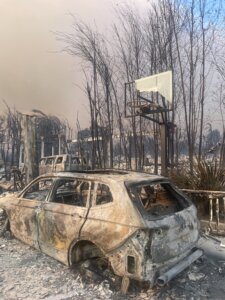
An unimaginable disaster
The blaze, one of the largest in the history of L.A., killed 12, destroyed nearly 7,000 structures and left the Pacific Palisades, an upscale town known for its coziness and exclusivity, virtually unrecognizable. Whole neighborhoods were wiped out, with countless iconic local landmarks badly damaged or reduced to rubble. KI members who lost their homes will never recover the ketubahs, menorahs and kiddush cups that infused their Jewish lives with meaning.
Yet the people whose homes were damaged, but not destroyed, have struggled as well. Thousands of Palisades residents had their insurance policies canceled months before the fire after the California insurance commissioner blocked an attempted rate hike; In lieu of private insurance, those homes were covered under the California FAIR Plan, the state’s last-resort insurer, which covers physical damage but not smoke damage, debris removal or alternative living expenses.
“Almost everybody was underinsured,” said Matt Ross, the president of KI’s board of trustees. “It’s a much more expensive process to rebuild than I think almost anybody realized.”
In the first days following the fire, the synagogue was able to help cover incidentals for congregants who were struggling to get money from their insurers. And with the support of members and the local Jewish federation, KI covered membership dues this year for everyone displaced by the fire.
Still, the months that followed have been an ongoing nightmare for many congregants. People described fighting with their insurance adjusters, navigating inscrutable municipal bureaucracy and being at the mercy of their neighbors — who hold the power to block new construction in some HOAs.
While Kehillat Israel escaped the flames, it did not dodge insurance trouble. Ross said that last summer, with remediation ongoing — and with the synagogue’s claim still open — the building’s insurer informed KI that it would not renew its policy. When they finally found replacement coverage, it was many times more expensive — taking a five-figure annual premium well into the six figures.
“It’s absolutely outrageous. It is really stunning,” said Ross, who also lost his home in the fire. “These are the kinds of challenges that not only individuals, but a synagogue or other house of worship faces.”
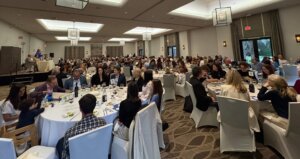
Community in exile
With congregants spread out across the Southland, the synagogue’s programming has moved to meet them, often in far-flung or esoteric locations.
A congregant hosted a Sukkot gathering in Hermosa Beach — nearly 20 miles away (and a lifetime in traffic) from KI’s main sanctuary — and other events as far east as Hollywood and north in the San Fernando Valley. The synagogue threw a Purim party at a bowling alley and celebrated Hanukkah at a brewery. It didn’t hide from joy.
“There are moments where you’re laughing,” Bernstein said, “and actually for a second forget that you’ve been through this horrible, horrible ordeal.”
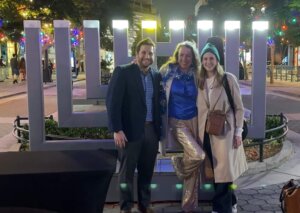
The most emotionally fraught Jewish event on the calendar was Passover. “I think for a lot of our folks, they had hosted Seder in the past, and they weren’t quite ready to figure out how to host not in their home,” Sher said. The synagogue hosted a Seder at a Bel Air hotel, where 300 people ate matzo and maror and shared the story of Jewish redemption.
And while no family heirloom can ever be replaced, new ones were being created. A national Judaica drive allowed L.A. wildfire victims to pick out ritual items from a veritable trove of donated candlesticks, prayer shawls and mezuzahs. Separately, KI organized a ketubah-and-vow-renewal ceremony, in which around 20 couples who had lost their Jewish marriage contracts in the fire signed new ones — and bore witness to each other’s marital vows.
That event was hosted at Leo Baeck Temple, one of countless local synagogues that have lent support to KI and other affected congregations in the past year. Sher said he and Bernstein had helped lead bar and bat mitzvah ceremonies in more than a dozen different sanctuaries in the last year.
“Anyone who’s going to pretend that this year hasn’t been weird, they’re being inauthentic,” Sher said. “But the fact that I still get to see that same bar and bat mitzvah family — just a different location, in a different venue, at a different moment — shows that we’re not going to be held back from these limitations. We’re still going to find ways to be together.”
Grieving alone, together
For the rabbis of Kehillat Israel, the scale of the tragedy could be hard to wrap one’s head around. On the one hand, no congregants perished in the fire — a clear blessing, or even a miracle. But there were well over a thousand who needed comforting — as did the rabbis themselves, who had been rendered homeless.
Bernstein, the synagogue’s senior rabbi, said that at first, she was just happy there was something she could do.
But days turned to weeks turned to months and she had barely been able to grieve her own losses: generations of family photos and correspondence; a lifetime of fine art collected from all over the world; a pair of shoes for every occasion and mood; and, of course, the home where she had raised her daughter.
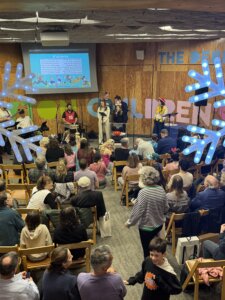
When she finally took time off last August — seven months after the fire — she realized she had waited too long.
“When we’re being of service, that alleviates some anxieties and sense of vulnerability,” Bernstein said, “but it masks other ways that you’re exhausting what few resources you have left.”
For the last year, Bernstein, her daughter and their German shepherd have been living in Santa Monica, in the home of a generous congregant. The insurance money for her former home went to her HOA, which is approaching a vote on whether to rebuild it; Bernstein said even she wasn’t sure it made financial sense.
Like many congregants in the Palisades diaspora, she’s stuck in a holding pattern, wanting to buy new things but having nowhere to put them, as the rest of the world has seemingly moved on. The only people who get it are going through it themselves.
“There is this sense of belonging to a club no one wants to belong to,” she said. “But also it’s a real sense that we’ve been through something together, and we feel a little different than others who have no clue about what’s happened to us.”
Sher’s family, which has been living in Brentwood for the past year, is currently debating whether to rebuild on the lot that previously held their home, or find a different one.
He wasn’t sure how he’d be feeling on Wednesday, the first anniversary of the day he, Bernstein and so many others lost their homes.
Sher planned to take the day off work — attending a community gathering in the morning and spending the afternoon with his wife and three children.
“I’m going to give myself space for the fact that I’m not entirely sure where my head’s gonna be,” he said. “Again, this is a slow process, and it’s not over yet, but being gracious and kind to yourself along the way has been one of the main messages that we’ve really leaned on in order to have the wherewithal to do all of this.”
Plotting a comeback
Even as efforts to rebuild homes drag on, there is excitement about the future. Turnout at events has been strong all year, with more than 1,000 joining their High Holiday livestream, in addition to the hundreds who attended in person. In late May, Kehillat Israel will be marching their Torah scrolls back into the main sanctuary for the first time, honoring Cantor Chayim Frenkel’s 40th year at the synagogue.
No synagogue wants to be displaced from its sanctuary. But silver linings abound if you know where to look. The renovation was long overdue, and congregants who enter Kehillat Israel this spring will find a larger Torah ark and an entryway that, according to Sher, “really says you’re stepping into something special.”
Reopening their building will also afford KI another privilege — that of welcoming in Palisades faith communities whose buildings did not survive the fire.
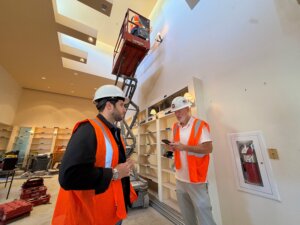
To this day, it remains unclear how much of the congregation will eventually return to the Palisades. One longtime member estimated 80% would be back — another guessed closer to three-fifths. Considering the members who had moved away but wanted to remain part of KI, Bernstein said satellite events and Zoom offerings would likely become a fixture.
Having endured this trauma together, the congregation will benefit from a perspective they could not have gained otherwise. Bernstein and Sher both brought up the resilience they had seen develop in their children over the past year. And the community, pressed into action by their circumstance, had been brought closer to each other and, maybe, to something holy.
Sher joked that he used to see more congregants in line at the farmer’s market than in prayer services. Now, he said, “We’ve had people come to our big events more excited than ever before, because they want to spend that time together and because we understand each other’s hardship. And that is really profound.”
The post ‘From a shtetl to a diaspora’: How a Palisades synagogue exiled by fire forged through appeared first on The Forward.

